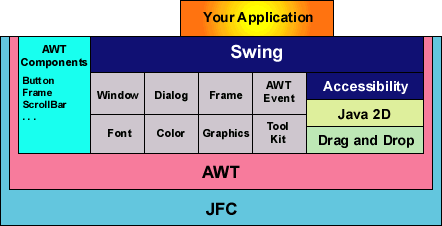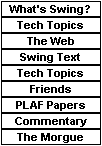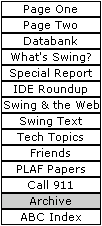|
By Mark Andrews
 The
Swing component set is a new graphical user-interface (GUI) toolkit
that simplifies and streamlines the development of windowing
components -- that is, the visual components (such as menus,
tool bars, dialogs and the like) that are used in graphically based
programs. The
Swing component set is a new graphical user-interface (GUI) toolkit
that simplifies and streamlines the development of windowing
components -- that is, the visual components (such as menus,
tool bars, dialogs and the like) that are used in graphically based
programs.
With Swing, you can develop powerful and scalable
GUIs that have precisely the "look and feel" that you
specify. That means that when you write a program using Swing components,
a user can execute your program without modification on any kind
of computer, and it will always look and feel just like a program
written specifically for the particular computer on which it is
running.
Furthermore, Swing components are said to be lightweight
because they don't rely on user-interface code that's native to
whatever operating system they're running on. Consequently, they
can usually be implemented using less code than earlier "heavyweight"
components require. (For more details on this topic, see the section
on "Lightweight and heavyweight components"
later in this article.)
A New Era of GUIs
When you create such a program and run it under Windows,
it has the appearance and behavior of a program written specifically
for Windows. When you run the same program on a UNIX workstation,
it runs just like any program written for UNIX. When you run it
on an Apple Macintosh, it looks and behaves just like any program
written specifically for the Mac -- and so on.
 There are also other ways to use Swing's PL&F capabilities.
For example, Swing comes with a special cross-platform look and
feel, named the Java look and feel, that always presents
a set of components with the same appearance and behavior, no matter
what operating system it is running on. There are also other ways to use Swing's PL&F capabilities.
For example, Swing comes with a special cross-platform look and
feel, named the Java look and feel, that always presents
a set of components with the same appearance and behavior, no matter
what operating system it is running on.
Finally, developers can create their own custom Swing
components -- or complete sets of custom Swing components
-- with any kind of look and feel they want to design.
This article introduces the Swing component set and
shows how Swing components differ from their pre-Swing AWT predecessors.
For a collective look at all the user-interface components in the
Swing set, see the "Component
Gallery" article. For more details about the classes,
interfaces, and methods used in Swing, see the article titled "The
Swing Tool Set." To learn more about the overall
architecture of Swing components, see "An
Overview of Swing Architecture."

Lightweight
and Heavyweight Components
The Swing toolkit breaks new ground in GUI (graphical
user interface) toolkit design because it is the first GUI toolkit
for the JavaTM programming language that lets developers
create lightweight components with a pluggable look-and-feel
design.
Because many "heavyweight" components are
used in programs that were written before Swing was introduced,
the creators of Swing have made it possible to mix heavyweight and
lightweight components in the same program. To learn how to do that,
see the article titled "Mixing
Heavy and Light Components" in The Swing Connection
archive.
(For more details about peer code, lightweight components,
and components in general, see the latest editions of The
Java Tutorial.)
Swing and AWT
From
an architectural standpoint, the Swing component set extends --
but does not replace -- the Abstract Windowing Toolkit (AWT) that
is familiar to users of the the JavaTM
programming language.
AWT, like Swing, is a set of object-oriented classes
designed to help programmers write graphical user interfaces, or
GUIs, for their Java programs.
Swing components are lightweight, just like the AWT
components that made their debut along with the release of JDK 1.1.
But the Swing set contains far more components than the pre-Swing
AWT toolkit did, and Swing components have many new features and
capabilities that old-style AWT components did not have. For example,
all Swing UI components are designed using the pluggable look-and-feel
(PL&F) architecture described in the article titled "An
Overview of Swing Architecture." You'll learn
about many other new features of Swing components as you read The
Swing Connection.
By offering all these new features, Swing significantly
extends and expands the power and versatility of the pre-Swing AWT
toolkit. More specifically, Swing extends the Lightweight UI Framework
that became part of the Java AWT with the introduction of JDK 1.1.
100% Pure Java
and Swing Beans
Many
of the components in the Swing set are 100% Pure JavaTM
versions of pre-Swing AWT components, such as Button, ScrollBar,
List, and so on. But Swing also includes a Pure Java set of higher-level
components (such as tree-view, list-box, and tabbed-pane components)
that were not available in the pre-Swing AWT API.
Swing components, like AWT components, adhere to the
specification that describes JavaBeans. Because JavaBean support
is built into the Swing tool set, Swing components can be easily
used in application-builder programs that make use of JavaBeans.
Swing and the
JFC library
The
Swing 1.0 tool set is implemented in Version 1.1 of the JavaTM
Foundation Classes (JFC), a class library that is designed to help
developers to build full-featured enterprise-ready applications.
Along with the Swing component set, JFC contains three major APIs:
- Java
2D, a set of classes for advanced 2D graphics
and imaging. Java 2D supplies Java applications with many different
paint styles, mechanisms for defining complex shapes, and classes
and methods for fine-tuning the rendering process.
- Drag
and Drop, a technology that enables data transfer
across Java and native applications, across Java applications,
and within a single Java application. The JFC
drag and drop specification is available on the java.sun.com
web site.
- The
Accessibility API, an interface that provides
assistive technologies such as screen magnifiers and audible
text readers. These technologies are designed to help people
with disabilities interact and communicate more easily and efficiently
with JFC and AWT components.
These three APIs are examined more closely in the
article titled "The
Swing Tool Set."

Swing Architecture
As noted at the beginning of
this article, Swing is an extension of the Abstract Windowing Toolkit
(AWT). Architecturally, in fact, Swing sits atop part (but
not all) of the AWT tool set, as shown in the following diagram.

The diagram shows how Swing sits on top of a number
of the APIs that implement the various parts
of JFC -- including the Java 2D and Drag and Drop APIs. Although
both those APIs are part of JFC, they are not part of Swing. That's
because certain tasks that they perform require use of native code.
And Swing components, as we have seen, never rely on peer code.
So Java 2D and Drag-and-Drop appear beneath, not inside, the rectangle
labeled "Swing" in the diagram. So does the old-style
AWT component set, which is extended (but not replaced) by Swing.
This doesn't mean that
you can't use pre-Swing APIs in your applications. They are all
still there, and you can use them if you like. In most cases, though,
you'll probably want to use Swing components, because there are
more of them and they offer a host of features and capabilities
that you won't find in older AWT components. The features and capabilities
of Swing components are what this document set is all about, so
to find out more about them, just read on.
You can learn much more about the overall architecture
of Swing components by reading the article titled "An
Overview of Swing Architecture" that appears in this
issue.
Differences between
AWT and Swing
One
of the most important differences between Swing and the pre-Swing
AWT toolkit is that Swing components don't borrow any native code
from the platforms on which they run. In other words, Swing does
not use any platform-specific implementations (which AWT programmers
used to refer to as "peers.") Instead, Swing creates its
components using pluggable look-and-feel (PL&F, or plaf)
modules that are written from scratch and don't use any native code
at all.
By default, Swing automatically plugs in the L&F
module that matches the platform you're running on, but because
of Swing's pluggable-L&F capabilities, you can also set up other
L&F modules to run in your GUI. Most of the L&F modules
can be plugged in regardless of what platform you're running on.
But a few of the platform L&F modules (currently Windows and,
coming soon, Mac) can be run only on the platform they represent
-- currently, Windows on Windows 95 and Windows NT, and (coming
soon) a Mac L&F for the Macintosh.
If you like, you can even design your own pluggable
L&F modules and use those in your application, no matter what
platform your program is running on. (Creating customized L&Fs
is the subject of a major article that will appear in the next issue
of The Swing Connection.)
You can even change look and feel of your application's
Swing components dynamically, at runtime, while your program is
being executed!
None of this would be possible if Swing used native
code supplied by the user's operating system, as earlier "heavyweight"
components did. The preceding diagram shows
how careful the creators of Swing were to free Swing completely
from the restrictions of using peer code.
As the picture shows, the Java 2D, accessibility,
and Drag and Drop APIs are part of JFC and are also part of AWT,
but are not part of Swing. That's because the tasks that these three
APIs perform force them to make use of native code. But Swing, as
we have noted, never uses native code.
Consequently, the designers of Swing just said "no"
to including the Java 2D, accessibility, and Drag and Drop APIs
within the Swing tool set. Additionally, to ensure that Swing runs
cleanly in a JDK 1.1 environment, the first release of the Swing
components do not take advantage of the Java 2D or Drag and Drop
APIs.
Of course, you can use these APIs in your Swing program
if it will be running in a 1.2 environment (and that's why they're
in the diagram). Real Swing integration with these new APIs is planned
for a future release.
The three parts
of Swing
Swing,
like Gaul, is divided into three parts. In fact, Swing is implemented
using three main elements that are now part of JFC:
- A brand-new set of components descended from a new component
named JComponentapi.
JComponent, descended from AWT's Container class, is the root
class of almost all Swing component classes. This hierarchy
allows Swing components -- even components such as Swing's label
component, JLabel -- to contain other components. This arrangement
makes Swing a very versatile tool set from the point of view
of component nesting.
- A group of Swing-related support classes. These classes
do not create visible Swing components that appear on the computer
screen, but do provide vital services to the Swing API and to
your Swing applications.
- A new set of Swing-related interfaces that are implemented
by Swing's component classes and support classes.
All three of these Swing elements are described in
much more detail in the article titled "The
Swing Tool Set."

Swing and IFC
 The
Swing design team, working closely with a peer engineering team
from Netscape, created Swing by incorporating the best features
of both the AWT and Netscape's IFC (Internet Foundation Class) library. The
Swing design team, working closely with a peer engineering team
from Netscape, created Swing by incorporating the best features
of both the AWT and Netscape's IFC (Internet Foundation Class) library.
Because Swing was developed in cooperation with engineers
from Netscape, in its infancy it bore a close resemblance to Netscape's
Internet Foundation Class class library (IFC). But that resemblance
vanished quickly, and from the the point of view of the developer,
Swing now bears little resemblance to IFC.
If you have developed programs with IFC, you might
notice some similarities in the default look and feel of Swing and
IFC widgets, because parts of Swing's rendering mechanisms are descended
from IFC. You might be able to pick out some other commonalties
as well, but not many -- especially since newly designed pluggable
L&Fs are now giving Swing components different looks and feels
in different implementations.
|



 There are also other ways to use Swing's PL&F capabilities.
For example, Swing comes with a special cross-platform look and
feel, named the Java look and feel, that always presents
a set of components with the same appearance and behavior, no matter
what operating system it is running on.
There are also other ways to use Swing's PL&F capabilities.
For example, Swing comes with a special cross-platform look and
feel, named the Java look and feel, that always presents
a set of components with the same appearance and behavior, no matter
what operating system it is running on.
 The
Swing design team, working closely with a peer engineering team
from Netscape, created Swing by incorporating the best features
of both the AWT and Netscape's IFC (Internet Foundation Class) library.
The
Swing design team, working closely with a peer engineering team
from Netscape, created Swing by incorporating the best features
of both the AWT and Netscape's IFC (Internet Foundation Class) library.